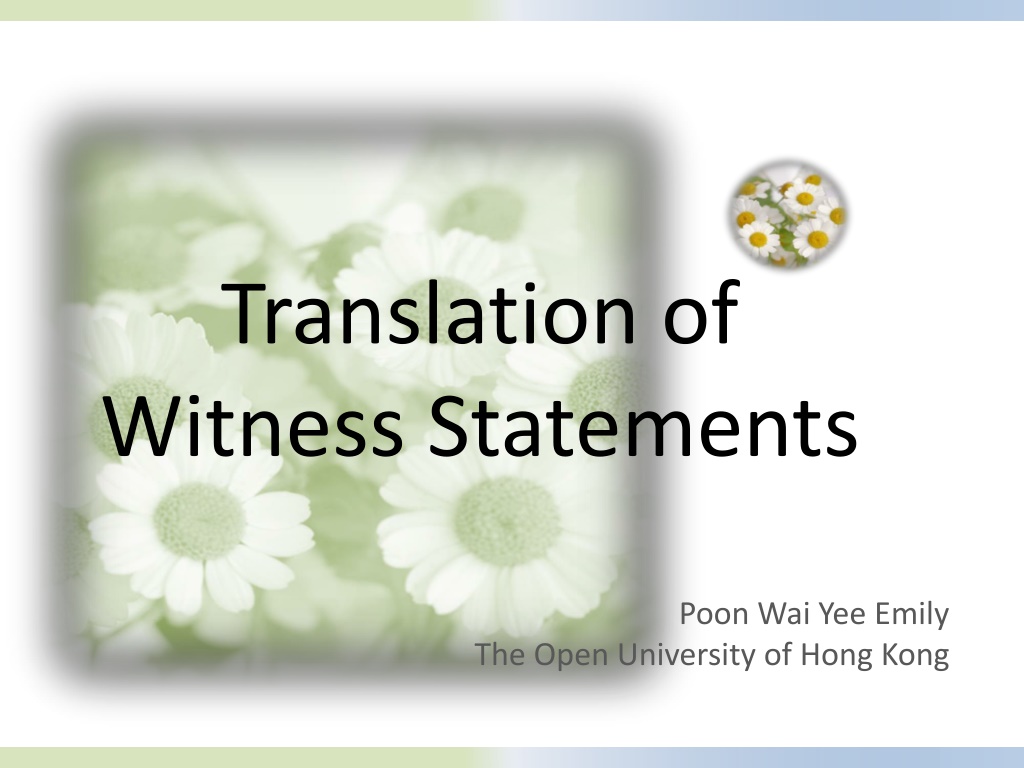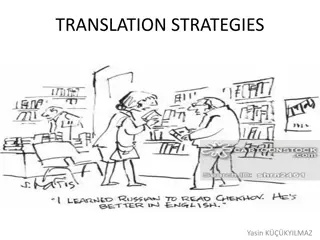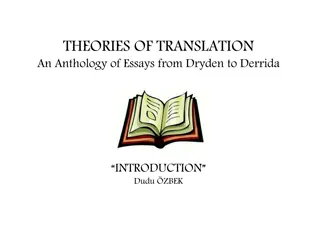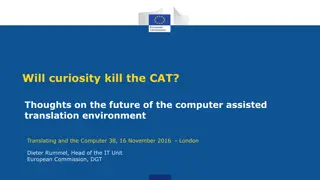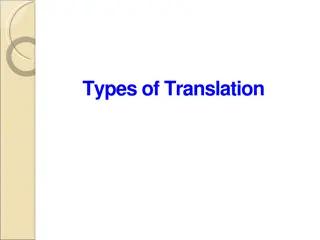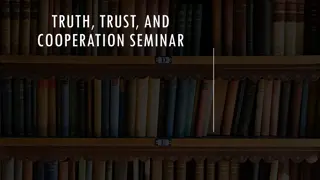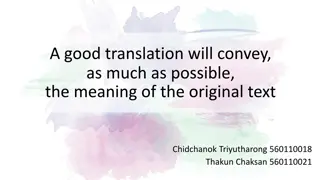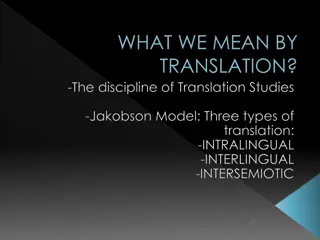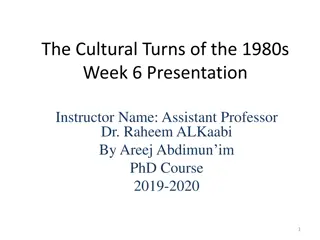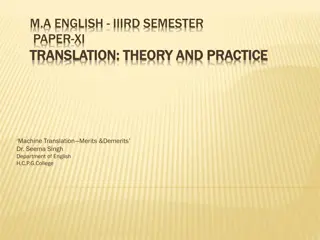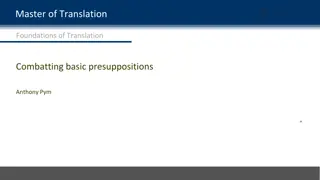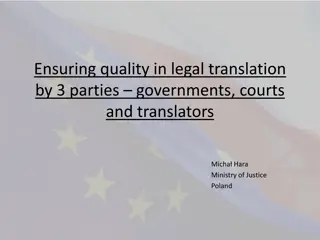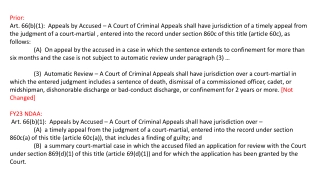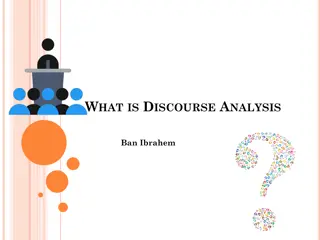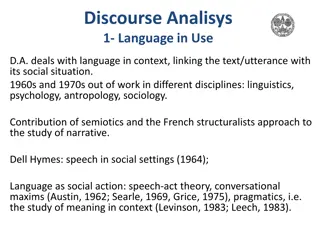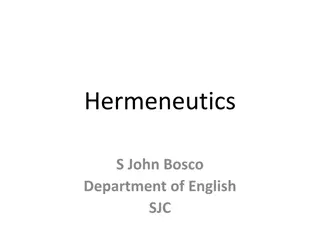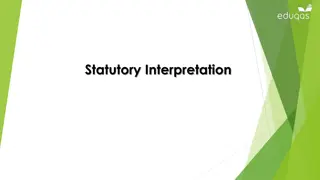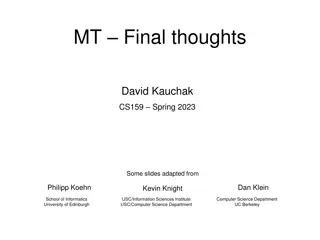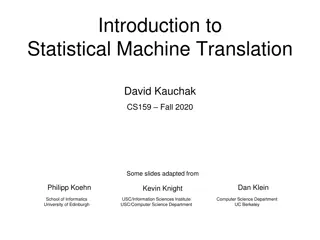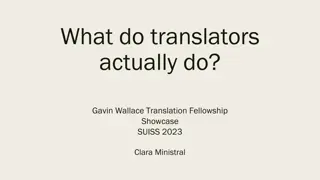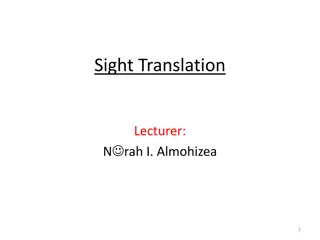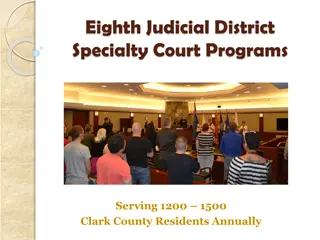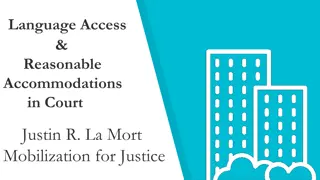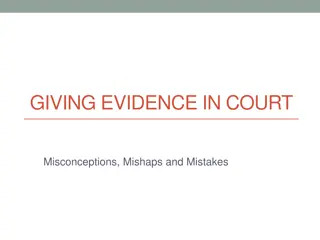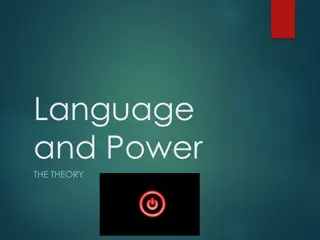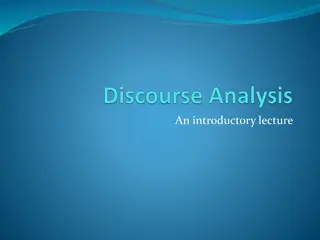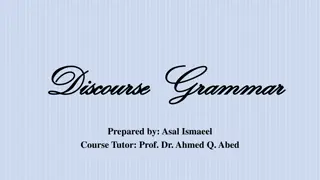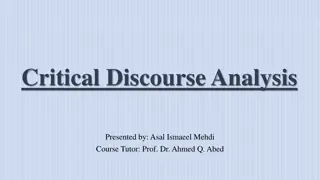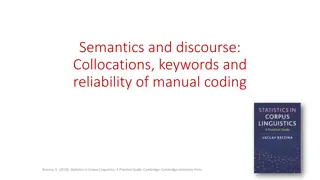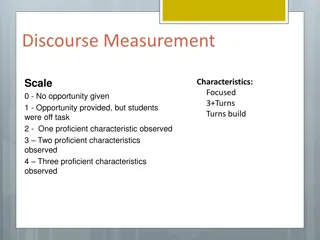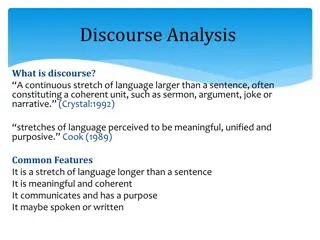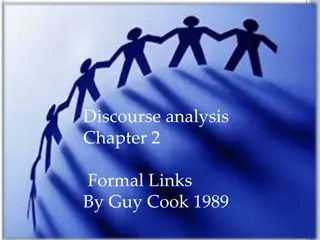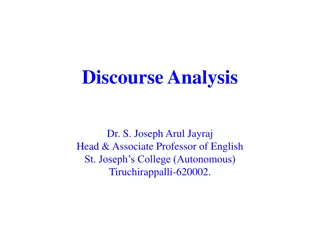Witness Statement Translation and Interpretation in Court Discourse
Characteristics of witness statements and the interpretation modes employed, the functions of witness statements, the dynamics of power in courtroom discourse, the importance of accuracy and neutrality in translation, the significance of meaning and style in conveying credibility, and examples illustrating the impact of language choices on message delivery in legal contexts.
Download Presentation

Please find below an Image/Link to download the presentation.
The content on the website is provided AS IS for your information and personal use only. It may not be sold, licensed, or shared on other websites without obtaining consent from the author. Download presentation by click this link. If you encounter any issues during the download, it is possible that the publisher has removed the file from their server.
E N D
Presentation Transcript
Translation of Witness Statements Poon Wai Yee Emily The Open University of Hong Kong
1. Characteristics of Witness Statement translation + interpretation mode of interpretation: consecutive interpretation ( ) + sight translation ( ) + whispering ( ) language: colloquial Cantonese court evidence: accuracy contribute to high quality translation and fidelity all
2. Function of Witness Statement The combination of expressive, informative and vocative. Function of a witness statement is a Expressive function: author-centred, the personal use the writer makes of his language. Informative function: the extralinguistic information content of the text. Vocative function: reader-centred (strong emotions and persuasive force) (Newmark 1982: 12)
3. Court Discourse Courtroom discourse shows a juxtaposition of power and powerlessness. Powerful participants will try to control a less powerful witness s testimony to influence the outcome of a case. The two parties in the courtroom have conflicting interests. Result: A translator is working for all parties, and is caught between conflicting interests and pressures. Therefore, his/her translation must be accurate and neutral.
5. Meaning and Style / Form Style / form contains critical elements of the message: voice level / tone hesitation false starts Meaning and style / form are important notions related to substance, and will be taken into consideration by the court to determine credibility.
5.1 Example X a. * Aren t you fxxking convinced? b. * You aren t happy about it, are you. Improved version: You seem damned unhappy about it, don t you? The word damned is not foul language. It is a strong word to imply an emphasis.
c. Dont fucking like it? Do you? It s spoken text. The use of the very strong expletive gets the idea across of strong dislike or great dissatisfaction . d. Do you feel fucking deflated? e. Frigging resentful, huh? Frigging is a strong word and euphemism for fucking.
6. Ambiguity 6.1 Disambiguate a sentence In order to approximate the original text as closely as possible with his translation, Rayar (1988: 542) held the view that a translator is first of all faced with having to disambiguate a sentence in question by specifying the meaning of the underspecified verb in that sentence. Question: Is it easy to disambiguate a sentence?
6.2 Invariable and variable meanings is defined as . A closer look at the definition reveals that the expression has a core meaning not to behave in an accurate manner , where one part of this core meaning not to behave accurately is invariable and the other part in a certain accurate manner is variable.
6.3 Contextual meaning To ascertain what a certain manner is, a translator has tolookatthecontext. The context can be: the other sentences in the text the world knowledge (including the legal knowledge) the translator possesses
Question: Based on what criteria that prompts a translator to activate certain types of knowledge and leave other types of knowledge unactivated? - admit the offence - please the triad society - repay a kindness - be clever to avoid punishment you practise trickery do not behave in a certain accurate manner
6.4 Examples and Solution Translate the invariable meaning only if you cannot specify the variable meaning
a. You should have learned the ropes once you are in the dubious business. Learn the ropes: learn the procedures or rules for doing sth. b. As one who practises trickery, you should have been wiser than this. c. You work in the underworld and should know the rules of the game. Underworld means criminal gangs/organized crimes. One doesn t need to be one of those to practice trickery would you call white collar criminals underworld figures? It is marginally acceptable.
d. * Youve been around in dishonest dealings for long but haven t learned appreciate my kindness. Comment: It is inappropriate to specify the variable meaning.
a. Chappy, you really don t know which direction the wind is blowing. See which way the wind is blowing: see what is likely to happen.
b. Little brother, you dont know the rules of the game. c. You really do not know how to make do. d. * Little brother, you shouldn t bite the hands that feed you. Bite the hand that feed one: be unfriendly to or harm somebody who has been kind to one. Comment: Variable meaning is added here.
7. Translation Methodology 7.1 Cultural gaps Definition: gaps which are due to differences in extralinguistic reality or lexical mapping (Ivir 1998: 37-38) In language, and especially in translation, there are disjunctions at the figurative level between symbols and the symbolized, between the figurative and its object, and between what it is meant to convey and what is actually conveyed. (Chen 2003: 41)
7.2 Linguistic Transfer: Source Language Oriented 7.2.1 Literal translation ( ) It is considered to be the best way to secure an equivalent effect in the translated version. Equivalent effect: Legal effect / legal intent. 7.2.2 Semantic translation ( ) (literal translation) Semantic translation attempts to render as closely as the semantic and syntactic structures of the second language allow, the exact contextual meaning of the original. Semantic translation remains within the original culture (Newmark 1982: 39)
in communicative as in semantic translation, provided that equivalent effect is secured, the literal word-for-word translation is not only the best, it is the only valid method of translation. (Newmark 1982: 39)
7.2.3 Examples a. You refuse a toast only to drink a penalty. What the student means here is that the toast is a drink offered in recognition of something (usually good), and a penalty drink is one where you are forced to drink something (perhaps because you made a mistake). It does have elements of encouragement and force , which is what the original text intends. b. You refuse to drink a toast only to be forced to drink a forfeit. Forfeit means penalty.
a. No one with hair wants to have favus on the scalp. b. Who would like to have a scabby head if there is hair on his head.
7.2.4 Comments: Culture is a product of tradition which has also been open to foreign influence Whether a culture can grow depends on its ability to gain a fresh appreciation of other cultures and traditions by means of translation. (Sun 2003: 27-28) excessive borrowing obscures one s own cultural identity. (Sun 2003: 26)
Strategy of Foreignization This is a way of taking the reader over to the foreign culture, making him or her see the cultural and linguistic differences (Sch ffner 1995:4) and is the strategy called foreignization by Venuti (Venuti 1995:1) This non-fluent translation style will disrupt the cultural codes of the target language and make visible the presence of the translator (Venuti 1995:20).
7.3 Cultural Transfer: The orientation is towards cultural rather than linguistic transfer. Translation is not viewed as a process of transcoding, but as an act of communication. Translation is oriented towards the function of the target text rather than prescriptions of the source text.
7.4 Functional Approaches: Target Language/ Reader Oriented. 7.4.1 Communicative translation ( ) (literal translation) Communicative translation attempts to produce on its readers an effect as close as possible to that obtained on the readers Communicative translation addresses itself solely to the second reader, who would expect a generous transfer of foreign elements into his own culture as well as his language where necessary. of the original. (Newmark 1982: 39)
7.4.2 Dynamic equivalence () Dynamic equivalence is to be defined in terms of the degree to which the receptors of the message in the receptor language respond to it in substantially the same manner as the receptors in the source language. (Nida and Taber 1982: 24)
7.4.3 Skopos theory (purpose of a translation) () The aim of any translation action, and the mode in which it is to be realized, are negotiated with the client who commissions the action the target text, the translatum (a term meaning the outcome of translational action), is oriented towards the target culture, and it is this which ultimately defines its adequacy. (Vermeer 1989: 173) In Vermeer s view, the translator has the power to decide what content should be offered according to the purpose of the target text specified by the needs of the target readers.
7.4.4 Examples a. You don t take the carrot but take the stick. The carrot idea comes from the old fashioned concept of using a carrot (attracted food) to entice a horse to move this carrot food being better than a stick, i.e. violent force. The while the stick means force/coercion. carrot means incentive/encouragement
b. You are asking for trouble. c. You don t take the easy way but the hard way./You choose the hard way, not the smooth way. d. You respond to the negative, not the positive.
a. Nobody wants to be in a tight spot. In a tight spot: (infml) in a difficult position or situation. b. Did I have any alternative?
7.4.5 Comments The functional approach may lead to a severe loss of the original meaning and therefore an absence of fidelity. Strategy of domestication To translate in a readable way in the target language conforms to one of the translation strategies within the invisibility theory proposed by Venuti (1995: 1). The above translation approach is a domesticating way of bringing the foreign culture to the reader in the target culture, making the text recognizable and familiar (Sch ffber 1995: 4)
7.5 Doubts serious doubts have been raised in many quarters by scholars of different backgrounds as to whether functional legitimately applied to legal texts, the main objections being centred recipient-orientedness, inadmissible for legal language. (Garzone 1999: 392) approaches can be on which their typical seems
7.6 Source Language Approach / Target Language Approach Which approach is better? This is rarely discussed and a court interpreter is free to adopt any approach s/he likes.
7.7 Solution An interpreter has to assess the communicative purpose of the original text to determine the approach s/he will adopt. S/he can adopt the target language approach if the cultural element is background information and not the focus of the case. The source language approach should be taken if the cultural element has legal implication. Faithfulness to the source language expression and its transparency in the target language are important to a judge s decision.
8 Creativity 8.1 Definitions In the course of archieving something new, mediators (translators and interpreters) have to resort to novel ways of encoding an old message. (Neubert 1997: 19) Particularly with regard to technical translation, translation and creativity seemed to be two diametrically opposed concepts. Therefore, the acknowledgment of a translator s creative input is limited in order to minimize the semblance of subjectivity and to keep up the myth of objectivity in translations. (Pommer 2008: 360)
even slight changes in language may affect the substance, translators must always take account of legal factors when making linguistic decisions. (Wilss 1988: 11, quoted from Pommer 2008: 360)
8.2 Examples: overtranslation/wrong translation 426 * he held the glass in a gesture which means ironside 426 in gangland. Comment: Ironside refers to a very old American TV series about crime. Ironside was a tough guy. Some triads may have copied this term. Gangland is used in American culture to mean the world of gangs as in the triad underworld.
*You are senior if you received respect, otherwise, you are pig. Pig doesn t mean stupid person in English. It means bad mannered, sloppy, or gluttonous.
8.3 Examples: unconventionality 426 a. Your Four Two Six is just wet behind the ears, doesn t even deserve to be mentioned in the same breath. (Still) wet behind the ears: (infml) (derog) immature or inexperienced; naive. In the same breath: immediately after saying sth that suggests the opposite intention or meaning.
b. You are just a new breed of 426 rank, nothing at all if compared to me. c. You are just an up-and-coming 426 and nowhere near in comparison with me. Up-and-coming: (infml) (of a person) making good progress; likely to succeed (esp. in a career). d. Your 426 is but a junior one, hardly my match.
e. Your 426 is only a green-horn not comparable to me. Greenhorn is American slang for someone who is new and inexperienced.
8.4 Example: novelty a. Since we are here on earth we may as well live and get on with it. I hardly had any choice except to admit this particular one. I planned to go to lie low in Taiwan. b. Since one exists in this world, one has no alternative Comment: Both a and b are literal translations with no creativity.
c. At the time, it was like Hobsons choice in the jungle out there . I couldn t but confess to it. I was thinking about heading for the hills in Taiwan. Hobson s choice is a free choice in which only ONE OPTION IS OFFERED which basically means the same as hardly any choice except to admit this particular one , and the use of the jungle and the hills I think is quite creative and appropriate. Hobson s choice means a choice of one thing from a list of one.
Bibliography Chen, Yongguo. 2003. The uncertainty of Translation . Perspectives: Studies in Translatology 11(1), 37-44. Gile, Daniel. 1991. A communication oriented analysis of quality in nonliterary translation and interpretation . In Larson Mildred L. (ed.). Translation: Theory and Practice Tension and Interdependence (American Translators Association Scholarly Monograph Series Vol. V), 188-200. Binghamton: State University of New York. Hjort-Pedersen, Mette and Dorrit Faber. 2001. Lexical ambiguity and legal translation: A discussion . Multilingua 20(4), 379-392. Ivir, Vladimir. 1998. Procedures and strategies for the translation of culture . In Gideon Toury (ed.). Translation Across Cultures, 37-48. New Delhi: Bahri Publications. Moeketsi, R.H. 1999. Discourse structure in a criminal trial of a magistrate s court . South African Journal of African Languages 19(1), 30-39. Neubert, Albrecht. 1997. Postulates for a theory of Translation . In Joseph H. Danks et al. (eds.). Cognitive Processes in Translating and Interpreting, 1-24. Thousand Oaks, CA: Sage.
Newmark, Peter. 1982. Approaches to Translation. Oxford: Pergamon Press. Nida, Eugene A. and Charles R. Taber, 1982. The Theory and Practice of Translation. Leiden: E.J. Brill. Pommer, Sieglinde E. 2008. No creativity in legal translation? Babel 54(4), 355- 368. Rayar, W. 1988. Problems with legal translation from the point of view of the translator . Nekemen P. (ed.). XIth World Congress of FIT: Translation, our Future. Maastricht: Euroterm. Sch ffner, Christina, 1995. Editorial , In Christina Sch ffner and Helen Kelly- Holmes (eds.). Cultural Function of Translation. Clevedon: Multilingual Matters Ltd. Sun, Yifeng, 2003. Translating cultural differences . Perspectives: Studies in Translatology 11(1), 25-36. Venuti, Lawrence, 1995. The Translator s Invisibility: A History of Translation. London: Routledge. Wilss, Wolfram, 1988. Kognition und bersetzen. T bingen: Niemeyer.
THE END THE END
